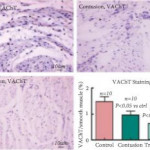Editorial: Correlating SCI with NGB
Breyer et al. [1] conclude from cystometry and antibody staining for vesicular acetylcholine transporter (VAChT) and calcitonin gene-related peptide (CGRP) in rats that both contusion spinal cord injury (cSCI) and transection spinal cord injury (tSCI), when compared with controls, increase bladder capacities and the number of non-voiding bladder contractions (with more non-voiding contractions in the cSCI than the tSCI group) and that the mean threshold (voiding) pressure was higher in the tSCI group than in the control or cSCI groups. These findings are consistent with detrusor sphincter dyssynergia. VAchT staining of the smooth muscle was lower in the cSCI and tSCI groups than in controls, and CGRP was also lower in the tSCI group compared with the cSCI and control groups.
An analysis of the spinal cord injury in these rats was not performed in the present study; therefore, although the tSCI group had a complete injury, the potential variability in cSCI was not determined, and so it is not possible to directly correlate the bladder findings with the SCI received. In addition, the bladder images do not show many of the neuronal elements in which VAChT and CRGP are found, and the immunohistochemistry staining is relatively sparse compared with other published images for the same neurotransmitters in the same region [2].
A similar study [3] including cSCI and tSCI models found that, while micturition pressure, non-voiding contractions, bladder capacity and post-void residual urine volumes differed from controls, there was no significant difference between the cSCI and tSCI groups. CGRP was significantly elevated in the dorsal horn in the SCI groups compared with the control group, but was not different between the SCI groups. These findings differ from those of Breyer et al., probably because of methodological differences in cSCI performance and the timing of studies in the experimental protocol.
Calcitonin gene-related peptide is primarily associated with afferent activity in the bladder [4], so it makes sense that afferent neurons would accumulate more CRGP in the bladder after tSCI, whereas the partial injury caused by contusion would allow some CRGP signal transmission, and thus not allow it to accumulate in the bladder. The efferent effects of CGRP in the urinary bladder are controversial; the effects in different preparations have led to conflicting results [4]. A similar argument may be made for VAChT in the bladder because VAChT is a good marker for cholinergic neurons [5], which are more likely to be involved in efferent pathways, although acetylcholine has also been shown to have a role in normal and spinal cord injury afferent pathways [6].
In humans, contusive injuries are much more common than transection injuries, the latter leading to varying degrees of incomplete recovery with time. There is a correlation between the length of cervical contusive injuries with changes in the American Spinal Injury Association scale reflecting outcomes. Long contusive injuries result in clinically complete spinal cord injuries, with shorter injuries resulting in more neurological improvement during the recovery period. Haematomas >4 mm have a worse prognosis in terms of recovery, as does cord ischaemia [7].
The variable nature of human spinal cord injuries is well known to urologists. Such injuries affect bladder function through detrusor sphincter dyssynergia and changes in bladder compliance and capacity, with variable degrees of hyperreflexia, and can lead to the complications of infection, incontinence, stone disease and the potential for renal insufficiency and renal failure. The identification of two phenotypes of bladder responses with regard to cSCI vs tSCI is a justifiable study conclusion, but a more complex pathophysiological model will likely emerge. The problem is that contusion injuries, although performed similarly each time, result in different neurological deficits, for a variety of reasons. Future studies must define both the neurological injury, anatomically and mechanistically, and the physiological changes occurring in the bladder. This would lead to a more comprehensive understanding of the pathophysiology behind both the short- and long-term spinal cord injury responses and how these correlate to the concurrent alterations and longer-term pathophysiological changes in the neurogenic bladder.
3 Mitsui T, Tanaka H, Moriya K, Kitta T, Kanno Y, Nonomura K. Lower Urinary tract function in Spinal Cord Injury Rats: Contusion versus Transection of the Spinal Cord. In: Scientific Programme, 41st Annual Meeting of the International Continence Society (ICS) 29 August – 2 September 2011, Glasgow, UK. Neurourology and Urodynamics. 2011: 30:787–1206



